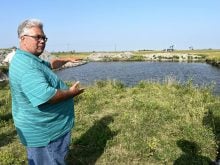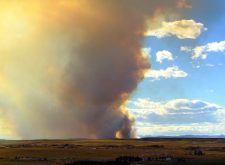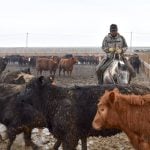The bathtub is almost full. It will begin to overflow momentarily, unless I do something right away. Do I pull the plug or turn off the tap? And maybe, just maybe, I could do a little of both to solve my impending dilemma.
After sitting in on a series of meetings in the southwest corner of Manitoba recently, including in the community of Pierson, it is painfully evident that, as a major spring flood lurks, water concerns are paramount in people’s minds. And the bulk of the discussion at these meetings is focused on drainage — the “pull the plug” option. Much of the concern centred on Saskatchewan drainage projects, specifically the 600 Drain Project, that would impact downstream residents inside the Manitoba border.
Read Also

Farmer gift idea: How about a weather station?
The 2025 holiday season is looming, and a home weather station might make a great Christmas gift for farmers
Let me be clear, and let me be fair: agricultural drainage is not the only cause of our current water woes, and Saskatchewan farmers are not the only villains. Manitoba producers are just as apt to be running the scraper or backhoe. And let me be equally clear: the solution to our predicament, one that took many generations to create, is not a longer, deeper, wider trench that simply passes the excess water to neighbours downstream.
There are arguments to be made, project examples to analyze and data to scrutinize on all aspects of this drainage issue. Here are three examples to add fodder to the debate:
- South Tobacco Creek in central Manitoba is a “turn off the tap” approach in an area where the debate over drainage policy goes back to 1880. Through a very large co-operative effort, peak flows on the creek have been reduced by 25 per cent, primarily through the use of 26 small dams and retention structures. The dams helped to reduce road washouts and local taxpayer expenditures to fix them.
- Smith Creek between Yorkton and Russell is a “pull the plug” approach. In 1958, wetlands covered 24 per cent of the watershed. A recent analysis found the percentage had dropped to 11 per cent by 2011. Drainage of these wetlands increased peak flow on Smith Creek by 78 per cent and increased flow volume by 32 per cent. The study further predicted that restoring wetlands to their 1958 level would decrease stream flow volume by 28 per cent, and the peak flow by 32 per cent. Think of the impact those reductions could have on the flows in the Assiniboine itself.
- In the Broughton Creek watershed in the Rivers area — another “pull the plug” approach — a similar picture emerged. Between 1968 and 2005, drainage resulted in the loss of 21 per cent of the watershed’s wetlands. Peak flows increased by 18 per cent and peak volumes by 30 per cent. Nutrient losses and siltation also increased dramatically. Those impacts are felt downstream as the Little Saskatchewan joins the Assiniboine.
These examples point ways forward, or paths to be avoided, if we are serious about addressing today’s watershed management issues in the Assiniboine River Basin.
Saskatchewan has begun this process with the adoption of new agriculture drainage regulations, through Bill 44. Several key points give some promise of improvements on the landscape. No existing drainage works are grandfathered: any structure can be reviewed, reassessed, and orders written with regard to rectifying any problems. A “no net loss” provision has been adopted: if you drain an acre, you must create an acre of wetland somewhere else. Downstream landowners must agree to any project that would move water onto or through their property. Drains will often require flow control structures. The overall process for submitting and approving projects has been streamlined, allowing for larger, multiple owner projects to perhaps move forward. And, if push comes to shove, very significant fines can be levied.
A case in point: the Dry Lake Project in southeastern Saskatchewan was just approved. This project involves 73 landowners and will affect 18,000 acres of farmland. The project will have 30 culvert gate structures that can be used to limit flow in peak periods, releasing water slowly as the downstream capacity becomes available. The project also will restore 34 acres of wetlands from existing drainage and 21 acres of wetland retention on new drainage. This last feature does not come close to achieving “no net loss,” but at least it is a step in the right direction.
Then there is the 600 Drain Project, the raison d’être for the Pierson meeting: 250 quarter sections, more than 30,000 acres affected, with many flow control structures throughout the project to manage flow rates and volumes. Perhaps the deal breaker of this Saskatchewan-led project is the fact that it requires a “point of adequate outlet” in Manitoba. Some 80 per cent of the impacted Saskatchewan producers are on side, but the mood of the Pierson meeting would suggest a much lower approval from landowners and municipalities in Manitoba. Given that these folks have experienced not one, but two one-in-300-year flood-magnitude events in the last five years, and a worst-case scenario for yet another to come this flood season, no one should be surprised if they are wary of any plan that sounds like plugs are being pulled farther upstream.
The common denominator of both of these projects is still very much a “pull the plug” approach, even though flow controls may mitigate the most extreme impacts of major spring floods and unusual rain events.
What is missing is a genuine mission to really “turn off the tap.” That process will only gain momentum when the mindset of many agricultural producers changes. Several solutions are available to us: small dams and retention structures; restoration and/or construction of wetlands; more perennial forages in crop rotations; preservation of natural grasslands; the use of cover crops; and intercropping to provide protection to exposed soils which are otherwise vulnerable as a result of our current annual cropping, monoculture practices.
Over time, adoption of these solutions will significantly reduce water flow speeds and volumes. Stay tuned for the opportunities that the Manitoba Forage and Grasslands Association’s Aquanty project — a new and powerful planning tool to demonstrate the value of different land use practices to watershed management — will bring to the table when the project reaches completion in a year’s time.
What is also missing is the clear indication that the public purse will be opened to assist producers in adopting more sustainable, resilient approaches to land and management. What we do in the Assiniboine Basin to manage the watershed more holistically has the potential to save villages, towns, rural municipalities and cities literally millions of dollars in potential flood response and recovery. I would much rather see public dollars put into an Alternate Land Use Services (ALUS) strategy that helps producers to mitigate and prevent floods through more resilient land use practices than see those same dollars build dikes, dig channels, or raise the heights of our major dams. Until we see that commitment from the provincial and federal governments, don’t expect producers to bear all of the cost.
I hope that the Manitoba government will consider many of these points as drainage regulations are finalized within its larger Surface Water Management Strategy. At a minimum, those regulations need to address the issues of no net loss of wetlands, no grandfathering of existing drainage works, an emphasis on smaller-scale water storage structures that are distributed throughout the watershed, full approval from downstream neighbours for any drainage project, and better use of land management practices that hold and store water in and on the ground. These approaches could be key elements of a provincial ALUS strategy that the government has advocated, and many citizens, rural and urban, have supported in principle.
I for one will look forward to the day when the plug will still be in the tub, the tap will be turned off, and all will be well.















